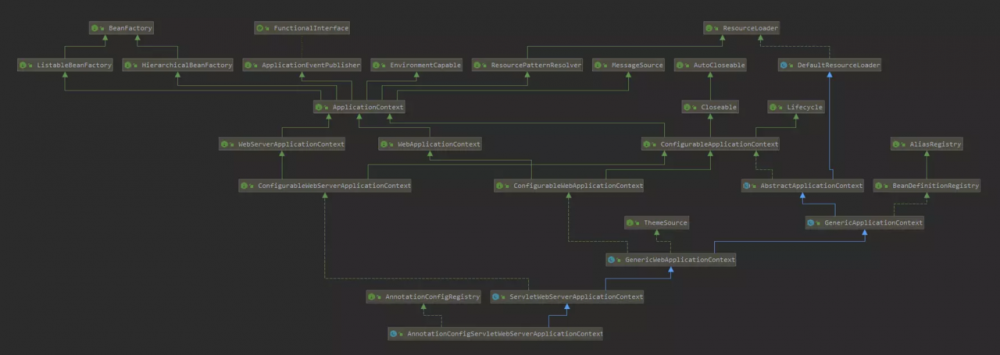SpringBoot启动流程源码分析(1)
springboot简化spring的大量xml的配置文件,为了实现统一化配置管理,一般参数配置 .properties文件或者 .yml文件,统一采用main方法来进行启动,内部集成了tomcat,实现安全监控,并且支持热部署。
`
@SpringBootApplication
public class DemoApplication {
public static void main(String[] args) {
SpringApplication.run(DemoApplication.class, args);
}
}
复制代码
调run方法之后,我们其实发现先去创建SpringApplication的实例。
public static ConfigurableApplicationContext run(Class<?> primarySource, String... args) {
return run(new Class[]{primarySource}, args);
}
public static ConfigurableApplicationContext run(Class<?>[] primarySources, String[] args) {
return (new SpringApplication(primarySources)).run(args);
}
复制代码
`
接下来我们来继续看构建SpringApplication实例的时候,做了什么具体细节。
`
public SpringApplication(ResourceLoader resourceLoader, Class<?>... primarySources) {
this.resourceLoader = resourceLoader;
Assert.notNull(primarySources, "PrimarySources must not be null");
this.primarySources = new LinkedHashSet<>(Arrays.asList(primarySources));
//推断应用类型,后面会根据类型初始化对应的环境。常用的一般都是servlet环境
this.webApplicationType = WebApplicationType.deduceFromClasspath();
////初始化classpath下 META-INF/spring.factories中已配置的ApplicationContextInitializer
setInitializers((Collection) getSpringFactoriesInstances(ApplicationContextInitializer.class));
//初始化classpath下所有已配置的 ApplicationListener
setListeners((Collection) getSpringFactoriesInstances(ApplicationListener.class));
//根据调用栈,推断出main方法的类名
this.mainApplicationClass = deduceMainApplicationClass();
}
复制代码
`
获取ApplicationContextInitializer实例的对象,会调用initialize方法。
`
private <T> Collection<T> getSpringFactoriesInstances(Class<T> type, Class<?>[] parameterTypes, Object... args) {
ClassLoader classLoader = getClassLoader();
// Use names and ensure unique to protect against duplicates
Set<String> names = new LinkedHashSet<>(SpringFactoriesLoader.loadFactoryNames(type, classLoader));
//创建springFactories实例
List<T> instances = createSpringFactoriesInstances(type, parameterTypes, classLoader, args, names);
AnnotationAwareOrderComparator.sort(instances);
return instances;
}
复制代码
`
获取ApplicationListener实例的对象,其中onApplicationEvent可以监听全部事件。
`
private <T> Collection<T> getSpringFactoriesInstances(Class<T> type, Class<?>[] parameterTypes, Object... args) {
ClassLoader classLoader = getClassLoader();
// Use names and ensure unique to protect against duplicates
Set<String> names = new LinkedHashSet<>(SpringFactoriesLoader.loadFactoryNames(type, classLoader));
List<T> instances = createSpringFactoriesInstances(type, parameterTypes, classLoader, args, names);
AnnotationAwareOrderComparator.sort(instances);
return instances;
}
复制代码
`
SpringApplication的run方法分析,启动spring容器,加载bean。
`
public ConfigurableApplicationContext run(String... args) {
//记录程序运行时间
StopWatch stopWatch = new StopWatch();
stopWatch.start();
//ConfigurableApplicationContext Spring上下文
ConfigurableApplicationContext context = null;
Collection<SpringBootExceptionReporter> exceptionReporters = new ArrayList<>();
configureHeadlessProperty();
//从META-INF/spring.factories中获取监听器
//1、获取并启动监听器。
SpringApplicationRunListeners listeners = getRunListeners(args);
listeners.starting();
try {
ApplicationArguments applicationArguments = new DefaultApplicationArguments(args);
//2、构建应用上下文环境
ConfigurableEnvironment environment = prepareEnvironment(listeners, applicationArguments);
configureIgnoreBeanInfo(environment);
//打印banner
Banner printedBanner = printBanner(environment);
//3、初始化应用上下文
context = createApplicationContext();
//实例化SpringBootExceptionReporter.class,用来支持报告
//关于启动报错
exceptionReporters = getSpringFactoriesInstances(SpringBootExceptionReporter.class,
new Class[] { ConfigurableApplicationContext.class }, context);
//4、刷新应用上下文前的准备阶段
prepareContext(context, environment, listeners, applicationArguments, printedBanner);
//5、刷新应用上下文
refreshContext(context);
//刷新应用上下文后的扩展接口
afterRefresh(context, applicationArguments);
//时间记录停止
stopWatch.stop();
if (this.logStartupInfo) {
new StartupInfoLogger(this.mainApplicationClass).logStarted(getApplicationLog(), stopWatch);
}
//发布容器启动完成事件
listeners.started(context);
callRunners(context, applicationArguments);
}
catch (Throwable ex) {
handleRunFailure(context, ex, exceptionReporters, listeners);
throw new IllegalStateException(ex);
}
try {
listeners.running(context);
}
catch (Throwable ex) {
handleRunFailure(context, ex, exceptionReporters, null);
throw new IllegalStateException(ex);
}
return context;
}
复制代码
`
我们这里来说明一下SpringApplication的run方法做了什么事情。
第一步:获取并启动监听器
第二步:构造应用上下文环境
第三步:初始化应用上下文
第四步:刷新应用上下文前的准备阶段
第五步:刷新应用上下文
第六步:刷新应用上下文后的扩展接口
①、启动监听器SpringApplicationRunListeners
`
private SpringApplicationRunListeners getRunListeners(String[] args) {
Class<?>[] types = new Class<?>[] { SpringApplication.class, String[].class };
return new SpringApplicationRunListeners(logger,
getSpringFactoriesInstances(SpringApplicationRunListener.class, types, this, args));
}
private <T> Collection<T> getSpringFactoriesInstances(Class<T> type, Class<?>[] parameterTypes, Object... args) {
ClassLoader classLoader = getClassLoader();
// Use names and ensure unique to protect against duplicates
Set<String> names = new LinkedHashSet<>(SpringFactoriesLoader.loadFactoryNames(type, classLoader));
List<T> instances = createSpringFactoriesInstances(type, parameterTypes, classLoader, args, names);
AnnotationAwareOrderComparator.sort(instances);
return instances;
}
复制代码
`
小伙伴有没有发现跟上面的ApplicationListener加载业务逻辑一样。EventPublishingRunListener开始监听事件。
②、构造应用上下文环境
构建应用上下文环境是去加载springboot的*.properties或者*.yml文件。 `
private ConfigurableEnvironment prepareEnvironment(SpringApplicationRunListeners listeners,
ApplicationArguments applicationArguments) {
// Create and configure the environment
//创建并且配置相应的环境
ConfigurableEnvironment environment = getOrCreateEnvironment();
//根据用户配置,配置environment系统环境
configureEnvironment(environment, applicationArguments.getSourceArgs());
//启动相应的监听器,其中一个重要的监听器 //ConfigFileApplicationListener 就是加载项目配置文件的监听器。
listeners.environmentPrepared(environment);
//绑定springbootApplication环境
bindToSpringApplication(environment);
if (!this.isCustomEnvironment) {
environment = new EnvironmentConverter(getClassLoader()).convertEnvironmentIfNecessary(environment,
deduceEnvironmentClass());
}
ConfigurationPropertySources.attach(environment);
return environment;
}
复制代码
`
③、初始化应用上下文
springboot应用上下文的环境,我们以SERVLET环境为例。
`
/** * The application should not run as a web application and should not start an * embedded web server. */ NONE, /** * The application should run as a servlet-based web application and should start an * embedded servlet web server. */ SERVLET, /** * The application should run as a reactive web application and should start an * embedded reactive web server. */ REACTIVE; 复制代码
`
下面是获取context上下文实例。 `
/**
* The class name of application context that will be used by default for non-web
* environments.
*/
public static final String DEFAULT_CONTEXT_CLASS = "org.springframework.context."
+ "annotation.AnnotationConfigApplicationContext";
/**
* The class name of application context that will be used by default for web
* environments.
*/
public static final String DEFAULT_SERVLET_WEB_CONTEXT_CLASS = "org.springframework.boot."
+ "web.servlet.context.AnnotationConfigServletWebServerApplicationContext";
/**
* The class name of application context that will be used by default for reactive web
* environments.
*/
public static final String DEFAULT_REACTIVE_WEB_CONTEXT_CLASS = "org.springframework."
+ "boot.web.reactive.context.AnnotationConfigReactiveWebServerApplicationContext";
//获取context实例
protected ConfigurableApplicationContext createApplicationContext() {
Class<?> contextClass = this.applicationContextClass;
if (contextClass == null) {
try {
switch (this.webApplicationType) {
case SERVLET:
contextClass = Class.forName(DEFAULT_SERVLET_WEB_CONTEXT_CLASS);
break;
case REACTIVE:
contextClass = Class.forName(DEFAULT_REACTIVE_WEB_CONTEXT_CLASS);
break;
default:
contextClass = Class.forName(DEFAULT_CONTEXT_CLASS);
}
}
catch (ClassNotFoundException ex) {
throw new IllegalStateException(
"Unable create a default ApplicationContext, " + "please specify an ApplicationContextClass",
ex);
}
}
return (ConfigurableApplicationContext) BeanUtils.instantiateClass(contextClass);
}
复制代码
` 对应三种类型,web应用构建上下文默认为AnnotationConfigServletWebServerApplicationContext。我们可以来看一下AnnotationConfigServletWebServerApplicationContext的实例图。

此图的继承关系如下:
AnnotationConfigServletWebServerApplicationContext类继承了ServletWebServerApplicationContext
ServletWebServerApplicationContext继承了GenericWebApplicationContext
GenericWebApplicationContext继承了GenericApplicationContext
GenericApplicationContext继承了AbstractApplicationContext
AbstractApplicationContext继承了DefaultResourceLoader
应用上下文可以理解成容器的高级表现形式,应用上下文确实在IOC容器基础上丰富了一些高级功能。











![[HBLOG]公众号](https://www.liuhaihua.cn/img/qrcode_gzh.jpg)

